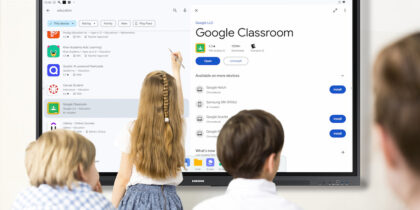Although we think of today’s students as tech-savvy, there’s a lot they need to learn — from basic technology skills to how to behave online. As a result, many teachers are striving to help their students achieve digital literacy.
How Schools Are Teaching Digital Literacy
In the Adams 12 Five Star Schools in Colorado, there is a well-defined digital literacy curriculum. Digital literacy coaches, like Chris Pontillo at Stellar Elementary School, help teach students skills such as how to find information in the school’s reference databases and online, how to use apps, and more. Each grade level at Stellar Elementary School has a Chromebook cart, and there are extra carts that teachers can check out from the media center. Pontillo visits classrooms and teaches digital literacy skills, and helps Stellar teachers integrate technology into the classroom.
In many school systems, the digital literacy curriculum isn’t as clearly defined. Valerie Lewis, an English language arts teacher at Discovery High School in Gwinnett County, Georgia, teaches her students important digital literacy skills by having them complete assignments on digital devices — but not through a formal curriculum. For example, Lewis has her students practice their writing skills by blogging about topics that interest them. They can choose whichever topic they want, but she gives them direction on what she’d like them to focus on each week. For instance, she may ask them to write with supporting details, or practice another writing skill that’s part of the state’s standards.
As she’s integrating technology in the classroom, Lewis also discusses key aspects of digital literacy with her students, such as making sure they know not to post personally identifiable information online, or making sure they treat others with respect when commenting on their peers’ blog posts.
The skills defined in a digital literacy curriculum can vary as much from district to district as how these skills are taught. In the Adams 12 Five Star Schools, the digital literacy curriculum includes the following:
- Information Literacy: The ability to find relevant information; the ability to evaluate information for reliability and validity; and the ability to use information to draw conclusions or create a product.
- Technology Literacy: The ability to select and use a variety of software, applications, mobile devices, online tools and programs to produce digital products.
- Digital Citizenship: The ability to use technology appropriately and responsibly.
Why It’s Necessary
As these two examples suggest, how students learn digital literacy skills varies widely. But whether school districts have a formal digital literacy curriculum or not, both Pontillo and Lewis agree that teaching students how to use technology effectively and be responsible digital citizens is essential.
“Even though we deal with a generation we believe is technologically sound, ironically they aren’t,” Lewis says. “I find that, even with composing a simple email, some students don’t know how to do that. They don’t know how to attach a file. They don’t know how to give proper credit when they find sources online.”
Digital Literacy Curriculum Resources
Pontillo, Lewis, and others use a variety of online tools and resources to teach digital literacy skills. For instance, Common Sense Media offers a free Digital Citizenship Curriculum, which includes lesson plans, digital interactives, assessments and professional development for teachers and materials for family education.
Another resource, Google Search Education, aims to help students become better at searching the Internet. The site includes lesson plans, online activities and advanced tips to develop students’ search literacy. Similarly, A Google a Day helps students practice their search skills by tasking them with finding certain information. One recent challenge asked, “An 11-foot bird lives less than two miles from 30.891383,-102.885032. What’s his name?” As Google explains on the site, “There’s no right way to solve it, but there’s only one right answer.”
Digital literacy is an important skill that teachers should be implementing in their classrooms. Whether a school uses digital literacy coaches, or teachers take their own initiative to teach these skills to their students, these examples prove that their efforts will go a long way.
Learn more about how technology is transforming education for today’s students.








